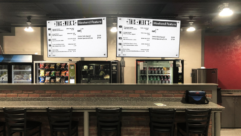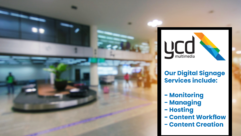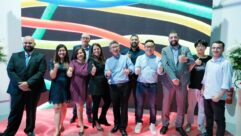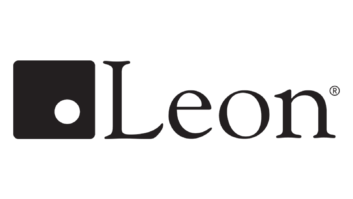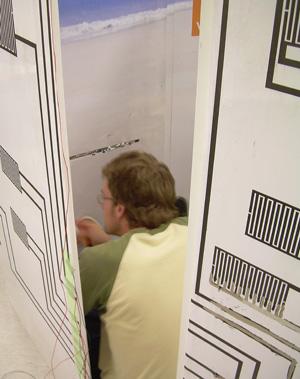

Interactive Signage: Are You Experienced?
The average adult is exposed to more than 600 ads each day, according to Media Dynamics, a New York-based consultancy. That’s a lot of ads, making it tougher and tougher for each one to stand out.
PAPER THAT TALKSA SOUND ALTERNATIVE
Paper Four’s interactive paper consists of touch-sensor pads and wiring printed using electrically conductive inks layered between cardboard and graphics.
Credit: Courtesy Paper Four
THE AVERAGE ADULT IS EXPOSED TO MORE than 600 ads each day, according to Media Dynamics, a New York-based consultancy. That’s a lot of ads, making it tougher and tougher for each one to stand out. That’s one key challenge facing out-of-home (OoH) media, a sector that’s growing rapidly as advertisers shift spending out of traditional media and into OoH platforms such asdigital signage. [See “OoH, Look at the Opportunity,” May 2008].
That growth is one reason why companies are spending more to develop technologies that stand out from the already crowded OoH pack. In the case of Japanese telecom giant NTT Communications, that meant appealing to noses in order to grab the attention of passers-by.
NTT’s Kaori Tsushin—meaning fragrance communication—technology can be paired with digital signage to emit one or more scents. An October 2007 trial at the Kirin City Beer Hall in Tokyo, Kaori Tsushin emitted lemon and orange scents, which were chosen to complement the beer.
Paper Four’s interactive paper consists of touch-sensor pads and wiring printed using electrically conductive inks layered between cardboard and graphics.
“In the trial, 70 percent of the passers-by reacted positively to the aroma-emitting advertisement,” says Yoriko Obokata, an NTT spokesperson. “Awareness of the digital signage was 5.28 times greater than for signage with no aroma-emitting function.”
Kaori Tsushin consists of a briefcase-sized diffuser that, in the current design, holds up to three aerosol cans of scents. Another component, called Spot Media, feeds content to the display, with Kaori Tsushin spraying the appropriate scent as each ad is served. The whole system is branded as Kaoru Digital Signage.
NTT also has conducted trials with cosmetics-maker Shiseido, whose ads were paired with a rose fragrance in the Shinjuku transit station, and Metropolitan Express, which used Kaoru at a highway rest area to dispense a fragrance designed to relax drivers. Those trials show the range of potential applications that NTT says can be used in locations such as retail stores, cafés, and office lobbies.
Kaoru Digital Signage is one recent example of what’s often referred to as “experiential” marketing or advertising. The goal is to go beyond basic sales pitches and create an experience—say by appealing to one or more senses—that cements the product and brand in the consumer’s mind. Some marketing experts argue that experiential marketing is key for reaching certain demographics, such as the coveted age 18-to-34 set.
Credit: Courtesy Paper Four
Half a world away in Sweden, another group of researchers is working on “interactive paper”—a thick, cardboard-like material embedded with loudspeakers and touch-sensitive areas. The basic concept is best explained with an example: Imagine a life-sized display in a theater lobby that looks much like the ones that have been hawking forthcoming movies for generations. One difference is that the interactive paper display has embedded speakers and touch sensors, so when patrons pat, say, Santa Claus’ belly, they hear a message about a new movie featuring him.
But like traditional cardboard displays, the interactive paper is designed to be cheap to the point that it can be discarded or recycled once a campaign is over. One reason is because the interactive paper uses printed electronics to keep costs low.
“It’s not rocket science, and it’s not magic,” says Mikael Gulliksson, a Mid Sweden University professor who helped develop the technology as part of a project dubbed Paper Four. (The project led to a spin-off company, Talkback Design, which is working to commercialize the technology and identify market opportunities.)
The Paper Four interactive paper is a sandwich of materials. The foundation comes from wellBoard Scandinavia, whose eponymously named material is similar to corrugated cardboard. About 1.5 inches thick, the corrugated “honeycomb” between the paper layers is laid out in a way that makes it flexible and lightweight yet strong. “By doing it that way, you get very robust material, almost like a building material, like plywood,” Gulliksson says.
The next layer in the Paper Four sandwich includes the touch-sensor pads and wiring, all printed using electrically conductive inks rather than with conventional wires and sensors. That design reduces weight, thickness, and cost. The second layer also includes very thin loudspeakers made out of foil. A strip of magnets glued to the back of the foil creates an electromagneticfield that vibrates two forks to create sound. The entire loudspeaker is manufactured using conventional roll-to-roll printing processes.
“The foil basically vibrates the way that a normal loudspeaker element would,” Gulliksson says. “It’s simply a flat loudspeaker based on a fork structure.”
Paper Four also has developed a printed loudspeaker that Gulliksson says is less expensive. The catch is that the sound isn’t as good, so for now, the design has reverted back to foil.
To improve the sound of the foil loudspeakers, Paper Four scoops out the wellBoard behind the foil to create resonance cavities. “That makes the loudspeaker foils a bit more efficient than they would be otherwise,” Gulliksson says.
Even so, the technology still has a somewhat limited frequency range, although Gulliksson wouldn’t specify the range. For example, the resonance cavities would have to be larger to produce more bass. But Gulliksson says that the overall sound is good enough for applications where decent fidelity is a plus, such as playing clips from a new album.
“We don’t ‘produce’ the really nice bass frequencies,” Gulliksson says. “But it’s fairly good. It’s actually good enough for reproducing tracks from ‘CD’.”
Another option—one enabled by wellBoard’s flexibility—is to curve the Paper Four in a way that puts the listener’s head between multiple speakers. And depending on the application, Paper Four also could be paired with conventional loudspeakers. For example, Gulliksson says that in semi-permanent applications such as retail displays—as opposed to more temporary ones like a trade show booth—stand-alone loudspeakers are used.
Interactive Signage: Are You Experienced?
The average adult is exposed to more than 600 ads each day, according to Media Dynamics, a New York-based consultancy. That’s a lot of ads, making it tougher and tougher for each one to stand out.
CHEAP AND DISPOSABLE
The final layer in Paper Four is the graphics, which can be printed on a variety of materials, such as wallpaper or billboard paper. The only requirement is that the graphics line up with the touch sensors.
There’s apparently no limit to the number of sensors that can be embedded or the shape they can take—Paper Four made a grand piano using its technology, with a separate sensor for each of the 88 keys.
The Paper Four system uses an MP3 player that is controlled by a microprocessor monitoring which sensor has been touched and then plays the accompanying audio clip. All of that hardware sits in a base, which powers the MP3 and microprocessor, and can be re-used. For example, in a store, the base could sit at the end of the aisle, with the merchant replacing the Paper Four displayevery week or month as promotions come and go.
In fact, between its use of paper and carbon-based inks, Paper Four is designed for short-term applications such as the walls of trade show booths and wayfinding signage at fairs and other events.
“It’s supposed to stay there for a week and then be thrown away,” says Gulliksson.
MORE INFORMATION
PRO AV:“OoH, Look at the Opportunity,” May 2008
Experiential Marketing Forum:www.experientialforum.com
NTT Communications:www.ntt.com/release_e/news07/0010/1017.html
Paper Four:mkv.itm.miun.se/projekt/paperfour
Talkback Design:www.talkbackdesign.se
WellBoard:www.wellboard.se
For retailers and other potential users, another possible benefit could be low cost compared to other signage technologies, which is largely a byproduct of using off-the-shelf materials such as wellBoard and established manufacturing processes such as inkjet and roll-to-roll printing. Another potential benefit is resolution. “Printed things normally look much better forthe simple reason that we have much, much better resolution in large formats than you can afford to have on a screen,” Gulliksson says.
Gulliksson says that Paper Four is less expensive than an LCD or plasma display, so it could be attractive for applications where basic interactivity is a plus but not to the point that it justifies spending $1,000 or more on a flat-panel, touch-screen display with audio.
That said, he also acknowledges that because it’s a new technology, Paper Four is still at the top of its cost curve, making it far pricier than traditional printed signs. Eventually, he believes, it will become more competitive with conventional, mute cardboard displays. The cost of Paper Four—and in turn its market potential—hinges on volume: The more displaysthat the company can produce, the more the cost drops.
Volume could get a boost if the company succeeds in scaling the technology down, possibly as small as product packaging. For example, a pharmaceutical company could use Paper Four to create packaging that speaks drug information to complement what’s printed on the box. For now, Gulliksson says, “It has its benefits, and it has its drawbacks as well.”
Tim Kridel is a freelance writer and analyst who covers telecom and technology based in Columbia, Mo. He can be reached at [email protected].


